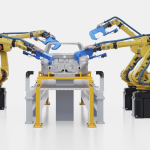Trade policy uncertainty is no longer just a temporary disruption—it is accelerating a fundamental restructuring of global supply chains. Manufacturers are moving beyond reactive tariff mitigation and investing in long-term changes to reduce geopolitical risk. From diversifying supplier bases to regionalizing production, businesses are designing supply chains that can withstand political volatility rather than simply reacting to it.
From Short-Term Shock to Long-Term Strategy
The latest wave of tariffs has reinforced a reality that supply chain leaders have been grappling with for years: global trade is becoming more fragmented. While past tariff disputes led to short-term pricing adjustments or supplier renegotiations, today’s manufacturers are making structural shifts that will define their supply chains for the next decade. Instead of adjusting sourcing on a case-by-case basis, companies are now investing in flexibility, redundancy, and automation to insulate themselves from political risk.
Manufacturers are no longer focused solely on whether specific tariffs will be reversed or expanded. The larger concern is how to ensure their supply networks are agile enough to respond to future trade restrictions, shifting government priorities, and regional economic policies. Instead of relying on a small number of sourcing hubs, many businesses are restructuring their supplier agreements and manufacturing footprints to create a more resilient operating model.
Rewiring Global Supply Networks for Political Volatility
The first wave of tariffs under the Trump administration saw many businesses making tactical moves to adjust costs. This time, the shift is far more structural. Global manufacturers are diversifying their sourcing models, expanding production in multiple regions, and ensuring that their supply chains are no longer overly dependent on a single country or trade bloc.
Manufacturers are shifting away from single-country dependencies and expanding operations across North America, Southeast Asia, and India to create greater sourcing flexibility. Rather than exiting China entirely, many companies are retaining a presence there while expanding operations in other regions to mitigate risk. Companies that previously relied on just-in-time inventory models are now reconsidering their approach, balancing cost efficiency with the need for supply chain resilience.
According to Andreas Haag, CEO of Streamliners Management Consulting, businesses must prepare for long-term volatility. He notes that many companies are struggling to determine whether tariffs will become a permanent fixture of global trade or remain a negotiating tactic, which makes planning more complex. He advises companies to take a long-term approach to supplier relationships, maintaining open communication with foreign partners even as they diversify their supply bases.
The Limits of Domestic Production as a Solution
One of the biggest questions surrounding tariffs is whether they will drive large-scale reshoring of manufacturing jobs. Early evidence suggests that while certain industries, particularly steel and aluminum, have seen job growth, the broader impact on U.S. manufacturing has been limited. The economic reality remains that shifting production back to the U.S. is expensive and constrained by labor shortages.
During the last round of tariffs, U.S. steel and aluminum jobs increased from 82,500 to 87,000 between 2017 and 2019, yet overall manufacturing job growth slowed significantly. The industry added just 61,000 jobs in 2019 compared to 264,000 in 2018. The labor shortage is a major factor in this trend. Even if tariffs create incentives for reshoring, the manufacturing sector continues to face a significant workforce gap. Without a stronger pipeline of skilled labor, companies will struggle to shift production at scale.
According to Panos Kouvelis, a supply chain professor at Washington University in St. Louis, past tariff cycles show that reshoring remains a limited solution. He argues that while some industries will see a boost, broad-based manufacturing repatriation is unlikely given current cost structures and labor constraints.
Future-Proofing Against the Next Trade Disruption
Even if the latest tariffs are revised or reversed, manufacturers are increasingly recognizing that trade policy shifts will continue to shape supply chain strategy. The broader trend toward protectionism is unlikely to reverse, with the U.S., Europe, and China all focusing on strengthening domestic industries and reducing reliance on foreign production.
Kouvelis suggests that global trade is moving toward a more protectionist future, where major economic regions such as North America, Europe, and Asia operate with greater self-sufficiency. This shift means companies must rethink how they structure their supply chains, ensuring they have the ability to quickly adapt to policy changes, new tariffs, or other geopolitical disruptions.
The last round of tariffs demonstrated that waiting for clarity before making strategic adjustments left many businesses exposed. Today’s manufacturers are taking a different approach, shifting from reactive tariff mitigation to long-term supply chain redesign. Those that can create flexible, multi-region production strategies will be best positioned to navigate the evolving trade landscape.







